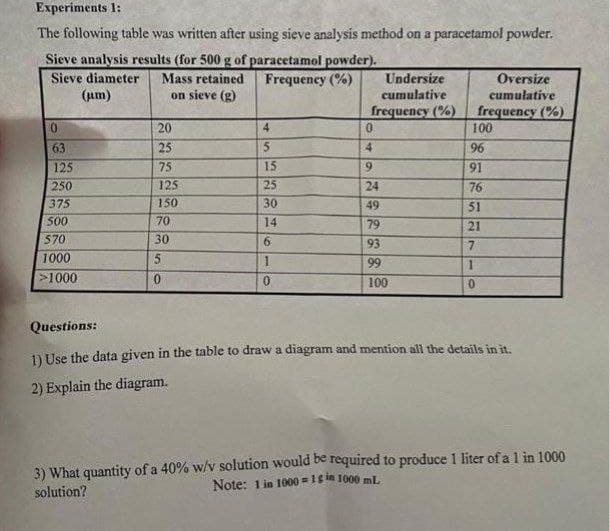The following table was written after using sieve analysis method on a paracetamol powder. Sieve analysis results (for 500 g of paracetamol powder). Mass retained on sieve (g) Sieve diameter Frequency (%) Undersize Oversize (um) cumulative cumulative frequency (%) frequency (%) 0. 20 4 0. 100 63 25 4. 96 125 75 15 6. 91 250 125 25 24 76 375 150 30 49 51 500 70 14 79 21 570 30 6. 93 1000 1 99 >1000 0. 100 Questions: D Use the data given in the table to draw a diagram and mention all the details in it. 2) Explain the diagram.
The following table was written after using sieve analysis method on a paracetamol powder. Sieve analysis results (for 500 g of paracetamol powder). Mass retained on sieve (g) Sieve diameter Frequency (%) Undersize Oversize (um) cumulative cumulative frequency (%) frequency (%) 0. 20 4 0. 100 63 25 4. 96 125 75 15 6. 91 250 125 25 24 76 375 150 30 49 51 500 70 14 79 21 570 30 6. 93 1000 1 99 >1000 0. 100 Questions: D Use the data given in the table to draw a diagram and mention all the details in it. 2) Explain the diagram.
Chapter8: Sampling, Standardization, And Calibration
Section: Chapter Questions
Problem 8.9QAP
Related questions
Question
I need the answer as soon as possible

Transcribed Image Text:Experiments 1:
The following table was written after using sieve analysis method on a paracetamol powder.
Sieve analysis results (for 500 g of paracetamol powder).
Sieve diameter
(um)
Mass retained
Frequency (%)
Undersize
cumulative
Oversize
on sieve (g)
cumulative
frequency (%)
frequency (%)
100
0.
20
4
63
25
4.
96
125
75
15
6.
91
250
125
25
24
76
375
150
30
49
51
500
70
14
79
21
570
30
6.
93
7.
1000
1.
99
>1000
0.
100
Questions:
DUse the data given in the table to draw a diagram and mention all the details in it.
2) Explain the diagram.
3) What quantity of a 40% w/v solution would be required to produce 1 liter of a l in 1000
solution?
Note: 1 in 1000 =16 n 1000 mL
Expert Solution
This question has been solved!
Explore an expertly crafted, step-by-step solution for a thorough understanding of key concepts.
Step by step
Solved in 2 steps with 2 images

Knowledge Booster
Learn more about
Need a deep-dive on the concept behind this application? Look no further. Learn more about this topic, chemistry and related others by exploring similar questions and additional content below.Recommended textbooks for you


Principles of Instrumental Analysis
Chemistry
ISBN:
9781305577213
Author:
Douglas A. Skoog, F. James Holler, Stanley R. Crouch
Publisher:
Cengage Learning


Principles of Instrumental Analysis
Chemistry
ISBN:
9781305577213
Author:
Douglas A. Skoog, F. James Holler, Stanley R. Crouch
Publisher:
Cengage Learning